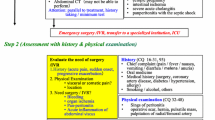Abstract
Background
Routine four-quadrant packing (4QP) for hemorrhage control immediately upon opening is a standard practice for acute trauma laparotomy. The aim of this study was to evaluate the utility of 4QP for bleeding control in acutely injured patients undergoing trauma laparotomy.
Methods
Retrospective single-center study (01/2015–07/2019), including adult patients who underwent trauma laparotomy within 4 h of admission. Only patients with active intra-abdominal hemorrhage, defined as bleeding within the peritoneal cavity or expanding retroperitoneal hematoma, were considered for analysis. Bleeding sources were categorized anatomically: liver/retrohepatic inferior vena cava (RIVC), spleen, retroperitoneal zones 1, 2 and 3, mesentery and others. Hemorrhage was further categorized as originating from a single bleeding site (SBS) or from multiple bleeding sites (MBS). The effectiveness of directed versus 4QP was evaluated for bleeding from the liver/RIVC, spleen and retroperitoneal zone 3, areas that are potentially compressible. Directed packing was defined as indicated if the bleeding was restricted to one of the anatomic sites suitable for packing, 4QP was defined as indicated if ≥ 2 of the anatomic sites suitable for packing were bleeding.
Results
During the study time frame, 924 patients underwent trauma laparotomy, of which 148 (16%) had active intra-abdominal hemorrhage. Of these, 47% had a SBS and 53% had MBS. The liver/RIVC was the most common bleeding source in both patients with SBS (42%) and in patients with MBS (54%). According to our predefined indications, 22 of 148 patients (15%) would have benefitted from initial 4QP, 90 of 148 patients (61%) from directed packing and 36 of 148 patients (24%) packing would not have been of any value.
Conclusion
Routine four-quadrant packing is frequently practiced. However, this is only required in a small proportion of patients undergoing trauma laparotomy. Directed packing can be equally effective, saves time and decreases the risk of iatrogenic injury from unnecessary packing.

Similar content being viewed by others
References
Cannon JW (2018) Hemorrhagic Shock. N Engl J Med 378:370–379
Marsden M, Carden R, Navaratne L et al (2018) Outcomes following trauma laparotomy for hypotensive trauma patients: A UK military and civilian perspective. J Trauma Acute Care Surg 85:620–625
Teixeira PG, Inaba K, Hadjizacharia P et al (2007) Preventable or potentially preventable mortality at a mature trauma center. J Trauma 63:1338–1346
Barbee RW, Reynolds PS, Ward KR (2010) Assessing shock resuscitation strategies by oxygen debt repayment. Shock 33:113–122
Clarke JR, Trooskin SZ, Doshi PJ et al (2002) Time to laparotomy for intra-abdominal bleeding from trauma does affect survival for delays up to 90 minutes. J Trauma 52:420–425
Barbosa RR, Rowell SE, Fox EE et al (2013) Increasing time to operation is associated with decreased survival in patients with a positive FAST examination requiring emergent laparotomy. J Trauma Acute Care Surg 75:S48-52
Sugrue M, D’Amours SK, Joshipura M (2004) Damage control surgery and the abdomen. Injury 35:642–648
Rotondo MF, Zonies DH (1997) The damage control sequence and underlying logic. Surg Clin North Am 77:761–777
Johnson JW, Gracias VH, Schwab CW et al (2001) Evolution in damage control for exsanguinating penetrating abdominal injury. J Trauma 51:261–271
Lee JC, Peitzman AB (2006) Damage-control laparotomy. Curr Opin Crit Care 12:346–350
Spahn DR, Bouillon B, Cerny V et al (2019) The European guideline on management of major bleeding and coagulopathy following trauma fifth edition. Crit Care 23(1), 98
Klingensmith ME, Chen LE, Glasgow SC et al (2008) The Washington Manual of Surgery, 5th edn. Lippincott Williams & Wilkins, Philadeplphia
Lu CK, Marks JA, Fundamentals of Exploratory Laparotomy for Trauma (2018) In: Fundamentals of General Surgery. Springer Nature, Cham, pp 275–288
Ahmed N, Vernick JJ (2011) Management of liver trauma in adults. J Emerg Trauma Shock 4:114–119
Coccolini F, Coimbra R, Ordonez C et al (2020) Liver trauma: WSES 2020 guidelines. World J Emerg Surg 15:24
Li Q, Dong J, Yang Y et al (2016) Retroperitoneal packing or angioembolization for haemorrhage control of pelvic fractures–Quasi-randomized clinical trial of 56 haemodynamically unstable patients with Injury Severity Score >/=33. Injury 47:395–401
Rodriguez C, Rhee P (2018) Damage Control Surgery: Military. Damage Control in Trauma Care. Springer Nature, Cham, pp 25–43
Eastridge B, Blackbourne LH, McBride KM (2017) Liver and Spleen Injury Management in Combat. Front Line Surgery A Practical Approach, 2nd edn. Springer Nature, Cham, pp 131–146
Frankel HL, Schlitzkus LL (2015) General principles of abdominal operations for trauma. Surgical techniques in trauma. Cambridge University Press, Cambridge, pp 165–171
Richardson JD (2005) Changes in the management of injuries to the liver and spleen. J Am Coll Surg 200:648–669
Feliciano DV (1989) Surgery for liver trauma. Surg Clin North Am 69:273–284
Shanmuganathan K, Mirvis SE, Chiu WC et al (2004) Penetrating torso trauma: triple-contrast helical CT in peritoneal violation and organ injury–a prospective study in 200 patients. Radiology 231:775–784
Matthes G, Stengel D, Seifert J et al (2003) Blunt liver injuries in polytrauma: results from a cohort study with the regular use of whole-body helical computed tomography. World J Surg 27:1124–1130
Funding
This research did not receive any specific grant from funding agencies in the public, commercial or not-for-profit sectors.
Author information
Authors and Affiliations
Contributions
DAJ, KI designed the study. DAJ and PL collected the data. DAJ analyzed data. DAJ and KI wrote the first draft of the manuscript. All authors contributed to the interpretation of the data and writing of the manuscript and approved the final version of the manuscript. KI supervised all aspects of study design, data acquisition, analyses and manuscript writing. The study was approved by the Institutional Review Board of the University of Southern California.
Corresponding author
Ethics declarations
Conflict of interest
All authors declare no potential conflict of interest.
Additional information
Publisher's Note
Springer Nature remains neutral with regard to jurisdictional claims in published maps and institutional affiliations.
Supplementary information
Below is the link to the electronic supplementary material.
Rights and permissions
About this article
Cite this article
Jakob, D.A., Liasidis, P., Schellenberg, M. et al. Intra-Abdominal Hemorrhage Control: The Need for Routine Four-Quadrant Packing Explored. World J Surg 45, 1014–1020 (2021). https://doi.org/10.1007/s00268-020-05906-3
Accepted:
Published:
Issue Date:
DOI: https://doi.org/10.1007/s00268-020-05906-3




